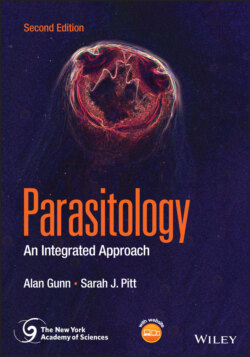Читать книгу Parasitology - Alan Gunn - Страница 70
Plastids in Parasites
ОглавлениеApicomplexans contain a unique organelle called the apicoplast that probably evolved from a chloroplast (plastid) although it does not contain any pigments. Molecular studies indicate that the protozoa currently comprising the Apicomplexa arose from at least three independent transitions of free‐living photosynthetic algae to intracellular parasites (Mathur et al. 2019). The apicoplast has four membranes and contains DNA although most of the genes that code for proteins within it have transferred to the nucleus. Interestingly, a protist, Chromera velia, that is phylogenetically related to the Apicomplexans contains a functioning plastid that is morphologically similar to that found in the Apicomplexans (Moore et al. 2008). Chromera velia is usually free‐living, but it can form endosymbiotic relationships with the larvae of certain corals. It is related to the dinoflagellate algae – a group that includes species that combine photosynthesis with other forms of nutrition, including predation. The apicoplast is of interest because it has no equivalent in the parasite’s animal hosts and therefore is a potential target for specifically designed chemotherapeutics. The apicoplast produces essential metabolites and the parasites die if exposed to drugs that interfere with its functions (Lim et al. 2016).
Molecular phylogeny suggests that some of the Kinetoplastida may also have contained plastids at an early stage in their evolution, but these have since been lost. Many euglenid protozoa contain chloroplasts (e.g., Euglena gracilis), and these are closely related to the Kinetoplastida. However, ultrastructural studies suggest that the euglenids acquired their plastids after the point at which they diverged from the Trypomastigota (Leander 2004).
